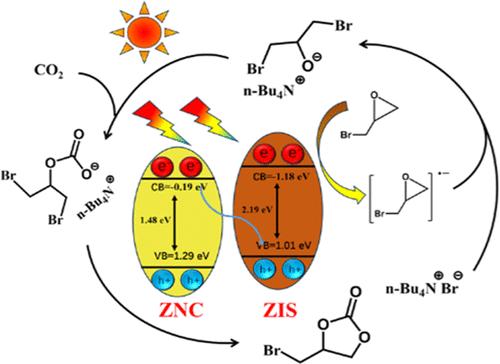当前位置:
X-MOL 学术
›
ACS Sustain. Chem. Eng.
›
论文详情
Our official English website, www.x-mol.net, welcomes your feedback! (Note: you will need to create a separate account there.)
2D/2D ZIF-L-Derived Znδ+ (0 ≤ δ ≤ 2) and N Codoped Carbon Skeleton@ZnIn2S4 S-Scheme Heterojunction for Solar-Driven CO2 Cycloaddition
ACS Sustainable Chemistry & Engineering ( IF 8.4 ) Pub Date : 2024-04-18 , DOI: 10.1021/acssuschemeng.3c08407 Bin Jiang 1 , Congcong Zhang 1 , Na Yang 1 , Qi Zhou 1 , Longfei Zhang 2 , Jingshuai Li 1 , Wei Yang 1 , Xiaodong Yang 1 , Luhong Zhang 1
ACS Sustainable Chemistry & Engineering ( IF 8.4 ) Pub Date : 2024-04-18 , DOI: 10.1021/acssuschemeng.3c08407 Bin Jiang 1 , Congcong Zhang 1 , Na Yang 1 , Qi Zhou 1 , Longfei Zhang 2 , Jingshuai Li 1 , Wei Yang 1 , Xiaodong Yang 1 , Luhong Zhang 1
Affiliation

|
Developing highly active photocatalysts that can directly utilize clean, cheap, and sustainable solar energy to achieve an efficient carbon dioxide (CO2) cycloaddition reaction under mild reaction conditions (1 bar of CO2) remains a great challenge. In this paper, 2D/2D ZnIn2S4/Zn-NC S-scheme heterojunction composites were constructed by the in situ growth of layered ZnIn2S4 on the surface of two-dimensional (2D) ZIF-L-derived Znδ+ (0 ≤ δ ≤ 2) and N codoped carbon skeletons (Zn-NC-T) via a low-temperature solvothermal method. The optimized ZnIn2S4/Zn-NC-T photocatalysts exhibited favorable photocatalytic CO2 cycloaddition performance, and the yield of cyclic carbonate reached about 98.8% under 10 mmol epoxides reactant, 1 bar CO2 pressure, and full-spectrum irradiation for 4 h. The favorable photocatalytic performance is attributed to the efficient photothermal conversion and effective separation of photogenerated carriers induced by the carbon matrix and heterojunctions, respectively. In addition, the stability of the heterojunction structure and activity were demonstrated through cyclic experiments. Furthermore, the possible mechanism of S-scheme heterojunction photocatalytic CO2 cycloaddition is proposed through electron paramagnetic resonance (EPR) spectra, cyclic voltammetry (CV) experiments, and quenching experiments. The mechanism analysis proved that light irradiation is conducive to the transfer of photogenerated electrons from the conduction band of ZnIn2S4 to epoxides, promoting the formation of ring-opening intermediates, and photogenerated holes may promote the coordination and polarization of adsorbed epoxides. This work not only prepared an S-scheme heterojunction catalyst with excellent photocatalytic CO2 cycloaddition performance but also provided new insights for the rational design of heterojunction catalysts for photocatalytic CO2 cycloaddition.
中文翻译:

用于太阳能驱动CO2环加成的2D/2D ZIF-L-衍生Znδ+ (0 ≤ δ ≤ 2) 和N共掺杂碳骨架@ZnIn2S4 S型异质结
开发可直接利用清洁、廉价且可持续的太阳能在温和反应条件(1 bar CO 2 )下实现高效二氧化碳(CO 2 )环加成反应的高活性光催化剂仍然是一个巨大的挑战。本文通过在二维(2D)ZIF-L 衍生的 Zn δ表面原位生长层状 ZnIn 2 S 4构建了 2D/2D ZnIn 2 S 4 /Zn-NC S 型异质结复合材料。 + (0 ≤ δ ≤ 2) 和 N 共掺杂碳骨架 (Zn-NC-T) 通过低温溶剂热法。优化后的ZnIn 2 S 4 /Zn-NC-T光催化剂表现出良好的光催化CO 2环加成性能,在10 mmol环氧化物反应物、1 bar CO 2压力和全光谱照射4小时下,环状碳酸酯的收率达到约98.8%。H。良好的光催化性能归因于碳基体和异质结分别诱导的有效光热转换和光生载流子的有效分离。此外,通过循环实验证明了异质结结构和活性的稳定性。此外,通过电子顺磁共振(EPR)谱、循环伏安(CV)实验和猝灭实验提出了S型异质结光催化CO 2环加成的可能机理。机理分析证明,光照射有利于光生电子从ZnIn 2 S 4导带转移到环氧化物,促进开环中间体的形成,光生空穴可能促进吸附环氧化物的配位和极化。该工作不仅制备了具有优异光催化CO 2环加成性能的S型异质结催化剂,而且为光催化CO 2环加成异质结催化剂的合理设计提供了新的见解。
更新日期:2024-04-18
中文翻译:

用于太阳能驱动CO2环加成的2D/2D ZIF-L-衍生Znδ+ (0 ≤ δ ≤ 2) 和N共掺杂碳骨架@ZnIn2S4 S型异质结
开发可直接利用清洁、廉价且可持续的太阳能在温和反应条件(1 bar CO 2 )下实现高效二氧化碳(CO 2 )环加成反应的高活性光催化剂仍然是一个巨大的挑战。本文通过在二维(2D)ZIF-L 衍生的 Zn δ表面原位生长层状 ZnIn 2 S 4构建了 2D/2D ZnIn 2 S 4 /Zn-NC S 型异质结复合材料。 + (0 ≤ δ ≤ 2) 和 N 共掺杂碳骨架 (Zn-NC-T) 通过低温溶剂热法。优化后的ZnIn 2 S 4 /Zn-NC-T光催化剂表现出良好的光催化CO 2环加成性能,在10 mmol环氧化物反应物、1 bar CO 2压力和全光谱照射4小时下,环状碳酸酯的收率达到约98.8%。H。良好的光催化性能归因于碳基体和异质结分别诱导的有效光热转换和光生载流子的有效分离。此外,通过循环实验证明了异质结结构和活性的稳定性。此外,通过电子顺磁共振(EPR)谱、循环伏安(CV)实验和猝灭实验提出了S型异质结光催化CO 2环加成的可能机理。机理分析证明,光照射有利于光生电子从ZnIn 2 S 4导带转移到环氧化物,促进开环中间体的形成,光生空穴可能促进吸附环氧化物的配位和极化。该工作不仅制备了具有优异光催化CO 2环加成性能的S型异质结催化剂,而且为光催化CO 2环加成异质结催化剂的合理设计提供了新的见解。



























 京公网安备 11010802027423号
京公网安备 11010802027423号